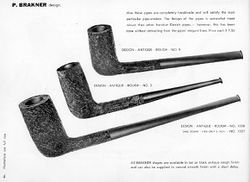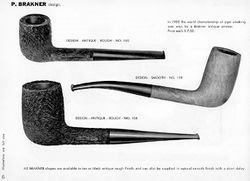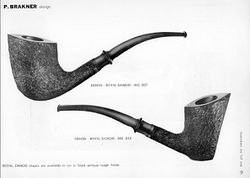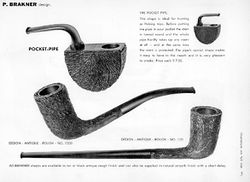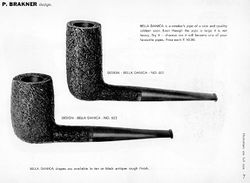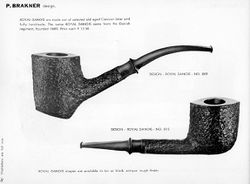Brakner: Difference between revisions
No edit summary |
No edit summary |
||
| Line 1: | Line 1: | ||
Peter Micklson (†) started his career at the Teofil Suhr workshop (Suhr’s Pibemageri) in Copenhagen, where [[Sixten Ivarsson]] was the foreman. He brought in [[Poul Rasmussen]] and taught him the two or three important things about pipemaking in a six weeks crash course, before he went off to join Poul Nielsen, the later Mr. Stanwell. | Peter Micklson (†) started his career at the Teofil Suhr workshop (Suhr’s Pibemageri) in Copenhagen, where [[Sixten Ivarsson]] was the foreman. He brought in [[Poul Rasmussen]] and taught him the two or three important things about pipemaking in a six weeks crash course, before he went off to join Poul Nielsen, the later Mr. Stanwell. | ||
Micklson, who later changed his last name to Brakner,can not have worked under Rasmussen too long before he felt to be good enough to go off on his own. Indeed he carved himself quite a good name as it was proudly announced 1955’s World Championship of Pipe Smoking was won by a smoker who employed a Peter Brakner pipe. | [[File:Brakner Rusticated Antique Billaird.jpg|thumb|Rusticated "Antique" finish Billiard, courtesy [http://smokingpipes.com Smokingpipes.com]]][[File:Brakner SmoothSitter.jpg|thumb|left|200px|Smooth Sitter, courtesy [http://pipephil.eu/logos/en/logo-b7.html Pipephil]]]Micklson, who later changed his last name to Brakner,can not have worked under Rasmussen too long before he felt to be good enough to go off on his own. Indeed he carved himself quite a good name as it was proudly announced 1955’s World Championship of Pipe Smoking was won by a smoker who employed a Peter Brakner pipe. | ||
His fame based fairly on developing an unique and very special "micro-rustication" he called Antique. According to [[Kai Nielsen]], Brakner kept this technique as a secret and only once he showed it to one person - Kai's mother. Both have passed away, so this secret technique is lost. [[Kent Rasmussen]] was recently inspired by Brakner's Antique finish when he created his new technique of rustication. | [[File:Brakner Rusticated AntiquePot.jpg|thumb|Rusticated "Antique" finish Freehand Pot, courtesy [http://smokingpipes.com Smokingpipes.com]]][[File:Brakner Rusticated AntiqueSitter.jpg|thumb|Rusticated "Antique" finish Sitter, courtesy [http://smokingpipes.com Smokingpipes.com]]]His fame based fairly on developing an unique and very special "micro-rustication" he called Antique. According to [[Kai Nielsen]], Brakner kept this technique as a secret and only once he showed it to one person - Kai's mother. Both have passed away, so this secret technique is lost. [[Kent Rasmussen]] was recently inspired by Brakner's Antique finish when he created his new technique of rustication. | ||
Brakner was a close friend of Ole Larsen, the proprietor of the famous [[W.Ø. Larsen]] tobacco shop and sold a lot of his pipes there, before Larsen hired his own indoor carvers. From the [http://www.finepipes.com/LarsenExportCatalog.htm Larsen Export Catalog 1960/61] we learn a bit about Brakner pipes: | [[File:Brakner Rusticated AntiqueStack.jpg|thumb|Rusticated "Antique" finish Stack, courtesy [http://smokershaven.com Smokershaven.com]]]Brakner was a close friend of Ole Larsen, the proprietor of the famous [[W.Ø. Larsen]] tobacco shop and sold a lot of his pipes there, before Larsen hired his own indoor carvers. From the [http://www.finepipes.com/LarsenExportCatalog.htm Larsen Export Catalog 1960/61] we learn a bit about Brakner pipes: | ||
* '''Antique''' series. Antique finish in tan or black. Smooth pipes also. Each pipe 7.50 $. | * '''Antique''' series. Antique finish in tan or black. Smooth pipes also. Each pipe 7.50 $. | ||
* '''Bella Danica''' series. Antique finish in tan or black. Each pipe 10.00 $. | * '''Bella Danica''' series. Antique finish in tan or black. Each pipe 10.00 $. | ||
| Line 11: | Line 11: | ||
The latter were named after the Royal Danish Guard Regiment, founded in 1689. | The latter were named after the Royal Danish Guard Regiment, founded in 1689. | ||
'''Here are links to two complete W.Ø. Larsen catalogs on Pipedia: [[File:Wo1.pdf]], and 1961-62: [[File:Wo2.pdf]], courtesy [http://Danishpipemakers.com Danishpipemakers.com], and a few example pages from the 1961-62 catalog bellow showing Brakner's pipes: | |||
<gallery perrow=3 Widths=250px Heights=200px> | |||
File:WOLarsen1961 62 Brakner1.jpg|Brakner in W.Ø. Larsen 1961-62 catalog | |||
File:WOLarsen1961 62 Brakner7.jpg|Brakner in W.Ø. Larsen 1961-62 catalog | |||
File:WOLarsen1961 62 Brakner4.jpg|Brakner in W.Ø. Larsen 1961-62 catalog | |||
File:WOLarsen1961 62 Brakner8.jpg|Brakner in W.Ø. Larsen 1961-62 catalog | |||
File:WOLarsen1961 62 Brakner6.jpg|Brakner in W.Ø. Larsen 1961-62 catalog | |||
File:WOLarsen1961 62 Brakner5.jpg|Brakner in W.Ø. Larsen 1961-62 catalog | |||
</gallery> | |||
After his sudden death Peter Brakner’s name faded in history | Brakner was one of the first high-end carvers from Denmark to enter the US market and was considerably successful there in the early 1970's. After his sudden death Peter Brakner’s name faded back from the forefront, but his pipes speak to the injustice of that. His body of work has earned him a place in the important history of Danish pipemaking. | ||
[[Category: Pipe makers by nationality]] | [[Category: Pipe makers by nationality]] | ||
[[Category: Denmark]] | [[Category: Denmark]] | ||
Revision as of 20:02, 5 June 2015
Peter Micklson (†) started his career at the Teofil Suhr workshop (Suhr’s Pibemageri) in Copenhagen, where Sixten Ivarsson was the foreman. He brought in Poul Rasmussen and taught him the two or three important things about pipemaking in a six weeks crash course, before he went off to join Poul Nielsen, the later Mr. Stanwell.
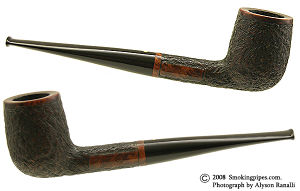
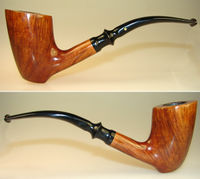
Micklson, who later changed his last name to Brakner,can not have worked under Rasmussen too long before he felt to be good enough to go off on his own. Indeed he carved himself quite a good name as it was proudly announced 1955’s World Championship of Pipe Smoking was won by a smoker who employed a Peter Brakner pipe.
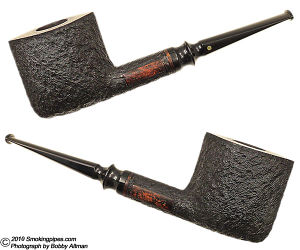
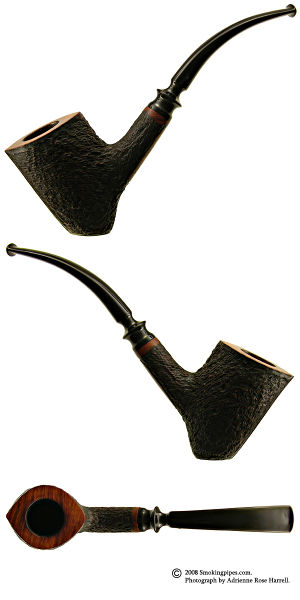
His fame based fairly on developing an unique and very special "micro-rustication" he called Antique. According to Kai Nielsen, Brakner kept this technique as a secret and only once he showed it to one person - Kai's mother. Both have passed away, so this secret technique is lost. Kent Rasmussen was recently inspired by Brakner's Antique finish when he created his new technique of rustication.
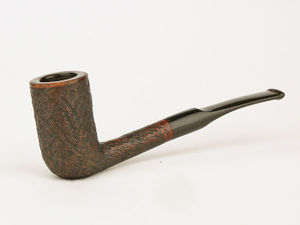
Brakner was a close friend of Ole Larsen, the proprietor of the famous W.Ø. Larsen tobacco shop and sold a lot of his pipes there, before Larsen hired his own indoor carvers. From the Larsen Export Catalog 1960/61 we learn a bit about Brakner pipes:
- Antique series. Antique finish in tan or black. Smooth pipes also. Each pipe 7.50 $.
- Bella Danica series. Antique finish in tan or black. Each pipe 10.00 $.
- Royal Danois series. Antique finish in tan or black. Each pipe 12.50 $.
The latter were named after the Royal Danish Guard Regiment, founded in 1689.
Here are links to two complete W.Ø. Larsen catalogs on Pipedia: File:Wo1.pdf, and 1961-62: File:Wo2.pdf, courtesy Danishpipemakers.com, and a few example pages from the 1961-62 catalog bellow showing Brakner's pipes:
Brakner was one of the first high-end carvers from Denmark to enter the US market and was considerably successful there in the early 1970's. After his sudden death Peter Brakner’s name faded back from the forefront, but his pipes speak to the injustice of that. His body of work has earned him a place in the important history of Danish pipemaking.
